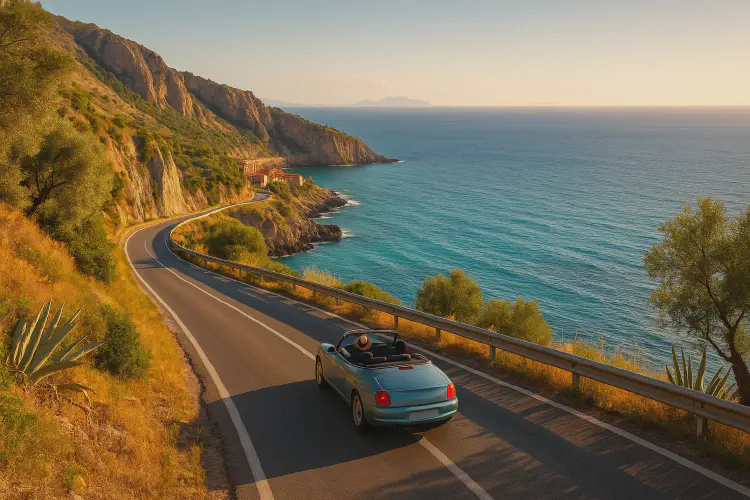How to get around Sicily
Getting around Sicily can be an adventure in itself — with scenic train routes, dramatic coastal drives, and mountain roads connecting centuries-old towns. Whether you prefer public transport or the freedom of a rental car, knowing how to navigate the island will make your trip smoother and more rewarding.
- Visit Sicily
- 3 min read

How to Get Around Sicily — Transportation Guide for Travelers
🚗 Overview
Sicily is Italy’s largest island, and while it’s possible to cross it in a few hours, its beauty lies in exploring slowly — from the beaches of Palermo to the slopes of Etna. You can travel by car, train, or bus, and even by ferry between smaller islands. Each option offers a different way to experience the island’s diverse landscapes and rhythms.
🚙 1. By Car — The Best Option for Freedom
Driving is the most flexible way to explore Sicily, especially if you want to visit rural areas, small towns, or natural parks.
Pros:
- Freedom to stop at viewpoints, beaches, and vineyards.
- Access to remote places like the Madonie Mountains or hidden Baroque villages.
- Scenic drives, such as the SS113 coastal road and Etna Wine Route.
Cons:
- City traffic (especially Palermo and Catania) can be chaotic.
- Parking is limited and often paid (strisce blu zones).
- ZTL (Limited Traffic Zones) in historic centers must be avoided to prevent fines.
Tips for drivers:
- Rent a compact car with GPS or smartphone navigation.
- Always check for damage when renting, and book full insurance.
- Fuel is expensive — expect around €1.90–€2.00 per liter.
🚆 2. By Train — Scenic and Comfortable for Major Routes
Trains in Sicily are operated by Trenitalia and connect most major cities.
Main lines:
- Palermo – Messina – Catania – Syracuse: the most scenic coastal route.
- Palermo – Agrigento: passes through stunning countryside.
Advantages:
- Comfortable, affordable, and air-conditioned.
- Great for long-distance travel between main cities.
Limitations:
- Some rural areas (like Ragusa or Noto) are poorly connected.
- Trains are slower compared to mainland Italy (average 60–80 km/h).
Tickets: available online at trenitalia.com or at station kiosks. Always validate paper tickets before boarding.
🚌 3. By Bus — Reaching Smaller Towns and Villages
Buses are an excellent way to reach places where trains don’t go.
Main operators:
- Interbus: connects Catania, Taormina, Noto, Syracuse.
- SAIS Autolinee: Palermo to Agrigento, Caltanissetta, and Enna.
- AST and Etna Trasporti: for local connections and smaller towns.
Tips:
- Buy tickets in advance from tabacchi shops or bus stations.
- Check timetables carefully — services may be reduced on Sundays and holidays.
⛴️ 4. By Ferry — Exploring Sicily and the Islands
Sicily is surrounded by smaller gems like the Aeolian, Egadi, and Pelagie Islands.
Main ferry ports: Palermo, Milazzo, Trapani, and Catania.
Popular routes:
- Milazzo → Aeolian Islands (Lipari, Vulcano, Stromboli)
- Trapani → Egadi Islands (Favignana, Levanzo, Marettimo)
- Messina → Mainland Italy (Villa San Giovanni)
Operators include Liberty Lines, Siremar, and Caronte & Tourist. Hydrofoils (aliscafi) are the fastest option.
🚲 5. By Bike, Scooter, or Funicular
- Scooters: great for short trips in Taormina, Cefalù, or Palermo’s outskirts.
- Bikes: ideal for flat coastal routes and nature reserves.
- Funiculars: connect hill towns like Taormina and Monte Pellegrino (Palermo) to nearby beaches.
✈️ 6. Domestic Flights and Airport Transfers
If you’re short on time, domestic flights can connect distant parts of Sicily quickly.
- Airports: Palermo (PMO), Catania (CTA), Trapani (TPS), and Comiso (CIY).
- Travel time: around 45 minutes between Palermo and Catania.
- For local transfers, use Alibus (Catania) or Prestia e Comandè (Palermo) airport buses.
🧭 Summary
Getting around Sicily depends on your pace and priorities. For full freedom, renting a car is ideal, but if you’re traveling between major towns, trains and buses are affordable and scenic. Combine them with ferries for island hopping and you’ll experience the island from every angle — mountains, coastlines, and charming villages all connected by Sicily’s timeless rhythm.